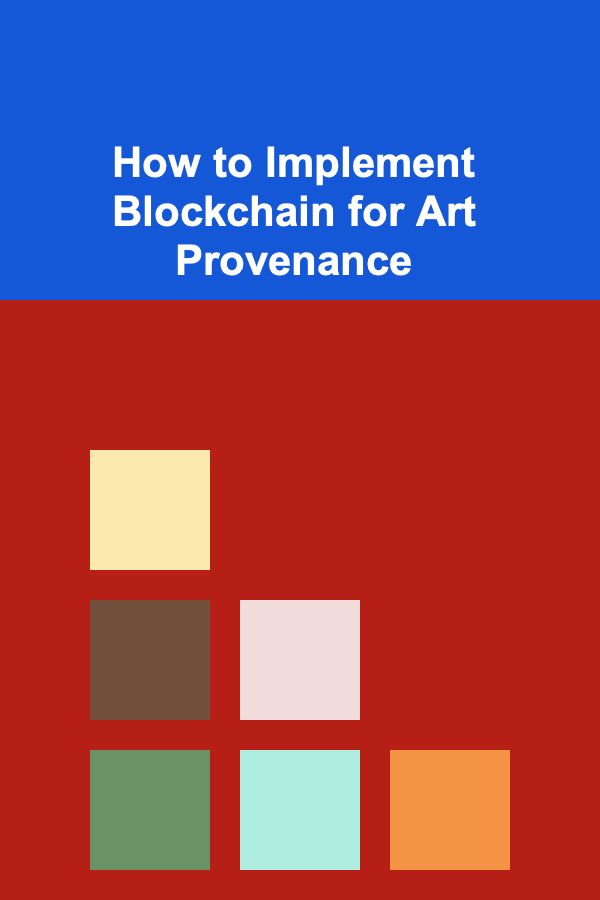
How to Implement Blockchain for Art Provenance
ebook include PDF & Audio bundle (Micro Guide)
$12.99$8.99
Limited Time Offer! Order within the next:

The art world has always struggled with authenticity, ownership, and provenance, often relying on paper-based documentation and word-of-mouth to verify the history of an artwork. With the rapid advancement of technology, blockchain has emerged as a potential solution to these problems, offering unprecedented security, transparency, and traceability in verifying the provenance of artwork. This article delves into how blockchain can be implemented in the art world to ensure the integrity and authenticity of art provenance, as well as the benefits and challenges of adopting this innovative technology.
What is Blockchain?
Blockchain technology is a decentralized, distributed ledger system that records transactions across multiple computers in a secure and transparent manner. Originally designed to support cryptocurrencies like Bitcoin, blockchain has since found applications in various sectors, including finance, supply chain management, and now, art.
At its core, blockchain is a chain of blocks containing data, where each block is linked to the previous one through cryptographic hashes. This creates a secure, immutable record of transactions, making it nearly impossible to alter or manipulate the data once it has been added to the blockchain.
The Problem of Art Provenance
Art provenance refers to the history of ownership of an artwork, tracing its journey from creation to the present. Provenance is crucial for establishing an artwork's authenticity, market value, and historical significance. However, the traditional methods of tracking provenance, such as paper certificates, gallery records, and auction house documentation, have inherent flaws:
- Forgery and Fraud: The art market is a prime target for fraud, with forgeries and stolen works being passed off as authentic. Art buyers and collectors often struggle to verify the provenance of pieces, leading to cases of misrepresentation.
- Loss of Documentation: In many cases, documentation that proves the ownership or authenticity of an artwork can be lost, damaged, or destroyed over time, leaving gaps in the artwork's history.
- Lack of Transparency: The art market is notoriously opaque, with limited access to information about a work's provenance. Buyers often rely on the word of galleries, dealers, or auction houses, which may have their own vested interests in the sale of the artwork.
- Complicated Ownership: In some instances, artworks change hands multiple times, and their ownership may be obscured or unclear. This can complicate the process of determining whether the work is legally owned, especially when it comes to restitution and claims of stolen art.
How Blockchain Can Solve These Problems
Blockchain can address many of the challenges associated with art provenance by providing a transparent, immutable, and decentralized system for tracking the history of an artwork. Below are some of the ways blockchain can improve art provenance:
1. Immutable Record of Ownership
Once an artwork's provenance is recorded on a blockchain, the information becomes immutable. This means that no one can alter or tamper with the artwork's history once it has been recorded. Each transaction (such as a change in ownership or a sale) is added to the blockchain, creating a permanent, unchangeable record of the artwork's history. This ensures that buyers can trust the authenticity of the information provided.
2. Transparency and Verification
Blockchain enables transparency by allowing anyone to access the history of an artwork. This is particularly beneficial for buyers, collectors, and galleries, as they can easily verify the artwork's provenance without relying on third-party intermediaries. The transparency provided by blockchain can help to reduce the risk of fraud and forgeries in the art market, as the history of each artwork is publicly available.
3. Decentralized and Secure
One of the key benefits of blockchain is its decentralized nature. Unlike traditional systems where records are kept by central authorities such as auction houses or galleries, blockchain is maintained by a network of nodes (computers), ensuring that no single entity has control over the records. This decentralization makes it much harder for any party to manipulate or falsify the provenance of an artwork. Additionally, blockchain uses cryptographic techniques to secure the data, making it highly resistant to hacking or tampering.
4. Traceability
Blockchain allows for real-time tracking of artwork transactions. Every time the artwork is sold, transferred, or authenticated, the event is logged on the blockchain, creating an immutable trail of ownership. This provides a clear and complete history of the artwork, making it easier to track the artwork's provenance from its creation to its current owner.
5. Reducing the Risk of Stolen Art
Blockchain can play a crucial role in preventing the sale of stolen art. By providing a secure and transparent record of ownership, blockchain makes it more difficult for stolen works to be resold without detection. Artworks that have been reported as stolen can be flagged on the blockchain, helping to prevent them from entering the market again.
6. Smart Contracts for Art Transactions
Smart contracts are self-executing contracts with the terms of the agreement directly written into code. These contracts automatically execute when predefined conditions are met. In the art world, smart contracts can be used to facilitate transactions and ensure that the terms of the sale are met. For example, when an artwork is sold, the smart contract could automatically transfer ownership and payment once both parties have agreed to the sale. This could streamline the process, reduce the need for intermediaries, and ensure that the transaction is secure.
Steps to Implement Blockchain for Art Provenance
To implement blockchain for art provenance, the following steps must be taken:
Step 1: Choosing a Blockchain Platform
The first step in implementing blockchain for art provenance is choosing a suitable blockchain platform. Several blockchain platforms can support art provenance, including:
- Ethereum: Known for its support for smart contracts, Ethereum is a popular choice for blockchain applications in the art world. It allows for the creation of non-fungible tokens (NFTs), which can be used to represent ownership of digital or physical artwork.
- Tezos: Tezos is another blockchain platform that has been used in the art world, particularly for creating NFTs. Tezos is known for its energy efficiency and low transaction costs, making it an attractive option for art provenance tracking.
- Hyperledger: Hyperledger is a permissioned blockchain platform, which means that it allows only authorized participants to access the blockchain. This can be useful for art provenance tracking, as it provides more control over who can participate in the network.
Step 2: Tokenizing Artworks
The next step is to tokenize the artwork. Tokenization involves creating a digital representation of the artwork on the blockchain. For physical artworks, this could involve creating a unique digital certificate (such as an NFT) that represents the artwork. For digital artworks, the artwork itself could be directly represented as a token on the blockchain.
Each token will be linked to specific metadata, such as:
- Title and description of the artwork
- Artist's name
- Date of creation
- Medium and dimensions
- Previous owners and sales history
This metadata is stored on the blockchain, making it accessible and verifiable for anyone who wishes to check the artwork's provenance.
Step 3: Recording Transactions
Once the artwork has been tokenized, each transaction involving the artwork (such as a sale, transfer, or auction) is recorded on the blockchain. These transactions are timestamped and linked to the previous transaction, creating a continuous, immutable chain of ownership. This record is publicly accessible, allowing anyone to verify the artwork's provenance and ensure that it is authentic.
Step 4: Integrating Blockchain with Existing Systems
In order for blockchain to be effectively integrated into the art market, it must work alongside existing systems and institutions, such as galleries, auction houses, and art dealers. These institutions can create digital records of their artwork transactions and link them to the blockchain, ensuring that the provenance is securely recorded.
Smart contracts can also be used to automate certain processes, such as royalty payments or transfer of ownership, further streamlining the workflow and reducing administrative overhead.
Step 5: Adoption and Education
For blockchain to be widely adopted in the art world, education and awareness are key. Artists, collectors, galleries, and auction houses must be educated about the benefits of blockchain technology and how it can be used to ensure the authenticity and provenance of artwork. Additionally, regulatory bodies may need to develop guidelines and standards for the use of blockchain in the art market.
Challenges and Considerations
While blockchain offers many benefits for art provenance, there are also challenges and considerations that must be addressed:
1. Adoption and Standardization
The art world is notoriously slow to adopt new technologies, and widespread adoption of blockchain may take time. In addition, there is a need for standardization in the way that artwork provenance is recorded on the blockchain. Without standardized practices, it may be difficult to ensure that blockchain records are consistent and accurate across different platforms and institutions.
2. Legal and Regulatory Issues
Blockchain's decentralized nature raises legal and regulatory challenges. For example, who owns the data on the blockchain? How do intellectual property laws apply to blockchain records? These legal issues must be addressed to ensure that blockchain-based art provenance systems are legally sound and widely accepted.
3. Security and Privacy Concerns
While blockchain is considered secure, there are still concerns about privacy and security, particularly when it comes to personal information linked to artworks. Ensuring that the blockchain platform protects sensitive data while maintaining transparency will be crucial for the success of blockchain-based art provenance.
Conclusion
Blockchain technology holds great promise for the art world, offering a secure, transparent, and immutable solution for tracking art provenance. By providing a decentralized and tamper-proof record of ownership and transaction history, blockchain can reduce the risk of fraud, forgeries, and stolen art, while ensuring that buyers and collectors can trust the authenticity of the artworks they purchase.
However, the successful implementation of blockchain for art provenance will require careful planning, education, and collaboration among artists, galleries, auction houses, and legal experts. By addressing the challenges and embracing the opportunities offered by blockchain, the art world can usher in a new era of transparency and security for art provenance.
Reading More From Our Other Websites
- [Reading Habit Tip 101] Why You're in a Reading Rut---and How to Get Out
- [Ziplining Tip 101] Beyond the Zip: Turning a Single Ride into a Year-Long Adventure Challenge
- [Home Party Planning 101] How to Decorate Your Home for a Gatsby-Inspired Party
- [Home Maintenance 101] How to Perform Regular Maintenance on Your Home's Refrigerator
- [Home Party Planning 101] How to Plan Party Games for Couples to Break the Ice
- [Home Maintenance 101] How to Keep Your Home's Electrical System Safe and Efficient
- [Digital Decluttering Tip 101] Why Regular Computer Cleanups Prevent Malware and Boost Security
- [Home Storage Solution 101] How to Store Shoes in a Way That Saves Space and Keeps Them Accessible
- [Home Maintenance 101] How to Prepare Your Home for a Home Inspection
- [Organization Tip 101] Why An Organized Workspace Enhances Remote Work Productivity

How To Create Graphics for Live Streaming
Read More
How to Make Money Online as a Sound Designer: 10 Actionable Ideas
Read More
How to Make the Most of Lighting in a Studio Apartment
Read More
The Ultimate Guide to Discount Shopping: How to Score the Best Deals
Read More
How to Start Big Air Skiing and Snowboarding
Read More
How to Develop a Landscaping Checklist for Xeriscaping
Read MoreOther Products

How To Create Graphics for Live Streaming
Read More
How to Make Money Online as a Sound Designer: 10 Actionable Ideas
Read More
How to Make the Most of Lighting in a Studio Apartment
Read More
The Ultimate Guide to Discount Shopping: How to Score the Best Deals
Read More
How to Start Big Air Skiing and Snowboarding
Read More